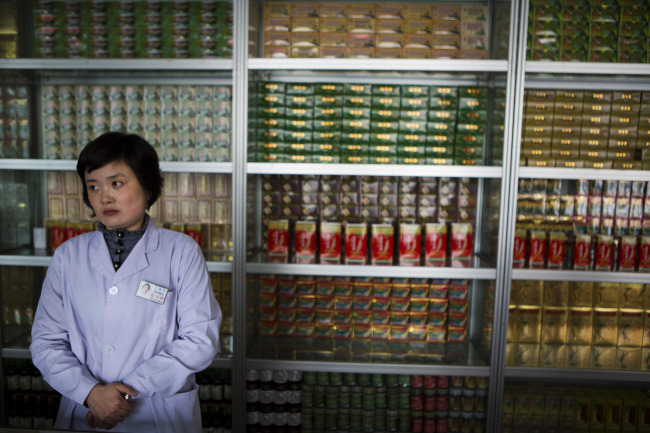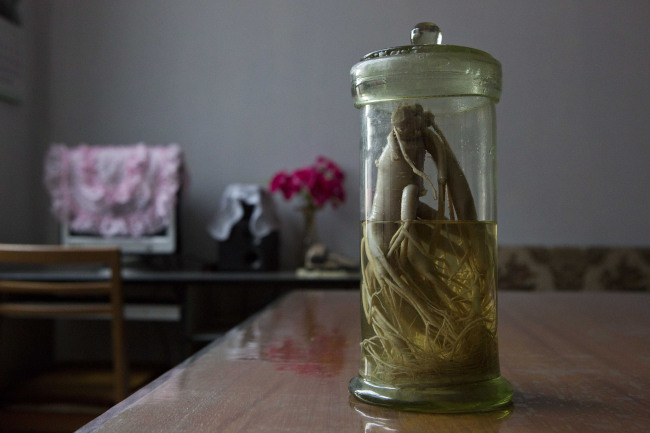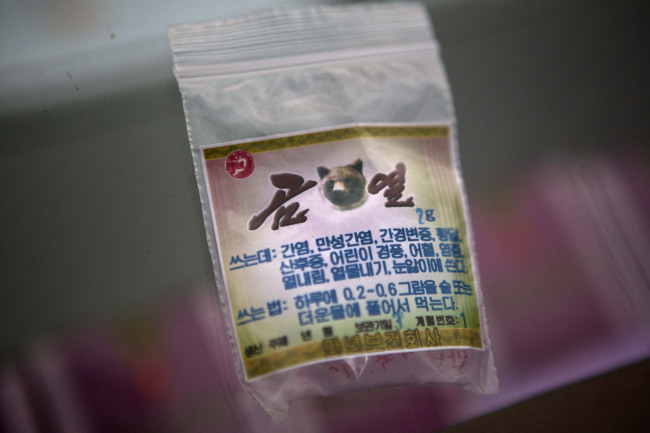PYONGYANG (AP) ― The Man Nyon Pharmacy is lined with rows of colorful packages containing everything from dried bear bile and deer antler elixir to tiger bone paste and ginseng. But the ancient “Koryo” medicine provided at this popular dispensary isn’t just for minor aches and pains.
It has been integrated into the health system from the smallest village clinic all the way up to the nicest showcase hospitals in the privileged capital of Pyongyang. Both modern and traditional styles of healing have long been uniquely intertwined nationwide with doctors from both schools working in tandem under one roof.
North Korean physicians say many patients prefer traditional medicine to the Western kind, but it’s difficult to determine the true situation in this closed and impoverished society where access is limited. Defectors, foreign aid workers and North Koreans agree that many Western drugs are scarce and say villagers still forage for plants in some areas to make their own herbal concoctions.
It has been integrated into the health system from the smallest village clinic all the way up to the nicest showcase hospitals in the privileged capital of Pyongyang. Both modern and traditional styles of healing have long been uniquely intertwined nationwide with doctors from both schools working in tandem under one roof.
North Korean physicians say many patients prefer traditional medicine to the Western kind, but it’s difficult to determine the true situation in this closed and impoverished society where access is limited. Defectors, foreign aid workers and North Koreans agree that many Western drugs are scarce and say villagers still forage for plants in some areas to make their own herbal concoctions.

With the U.N. Security Council imposing its toughest-ever sanctions following North Korea’s third nuclear test in February, patients may become even more dependent on these home-grown remedies in a country of 24 million people where government health spending ranks among the world’s lowest.
“Doctors are more interested in Koryo medicine rather than Western medicine because they can get it more easily,” said Ri Hye-yong, who manages the frigid concrete pharmacy opened by the government nearly three decades ago. “It’s much cheaper.”
The latest restrictions are meant to squeeze new young leader Kim Jong-un and the ruling class by clamping down on access to foreign travel and luxury goods. North Korea has responded with tirades that include threatening nuclear attacks against the U.S. and its allies.
The resolution is not supposed to block donor aid to those who need it most, including the two-thirds of the population who don’t have enough to eat. But foreign aid workers say years of limitations have created a maze of red tape and approvals needed to ship in medical supplies and equipment. Some countries refuse to process payments for anything involving North Korea because of restrictions placed on banks, while some foreign companies and organizations simply do not want to be involved once they learn where the materials are headed. But once the goods arrive, they say the process becomes fairly simple.
“Even though the imposed sanctions clearly exclude humanitarian assistance, a negative impact on the levels of humanitarian funding has been experienced,” the U.N. Resident Coordinator’s Office in Pyongyang said in a statement April 29, adding nearly three-quarters of the $147 million needed this year has not been received.
The World Health Organization is lacking an estimated 60 percent of the drugs it needs for at-risk kids and pregnant women, while the U.N. Children’s Fund is struggling to get vaccines and medicines to prevent the biggest killer diseases among children, it said.
In addition, the WHO says the process of importing essential equipment and medicine has also grown lengthy at all levels, and those involved have become over cautious in clearing materials to ensure they could not be classified as dual purpose or luxurious items.
International efforts to help boost the country’s ability to produce its own vaccines and medicines were earlier affected when some technology and seed microbes were halted over concerns they could potentially be used by Pyongyang for malicious purposes, WHO said.
Despite these challenges, it’s difficult to understand the full picture within North Korea where outsiders are banned from traveling freely and data are lacking or unreliable. Suspicion of the outside world is reinforced by huge hospital propaganda paintings depicting Americans and Japanese as the country’s “sworn enemies.”
Jang Jun Sang, a department director at the Ministry of Public Health, said in an interview in February that sanctions have cut imports of medical equipment and supplies
But he said North Korea was used to sanctions. “If we receive medical aid, that’s good,” he said. “But if we don’t, that’s fine, too. We’re not worried.”
North Korean factories have limited ability to produce pharmaceuticals, and many rural clinics lack electricity, running water and heating. By the government’s own account, more than 80 percent of village clinics suffer from “chronic shortages of medicines and supplies at all levels of the system.”
According to defectors such as Kwon Hyo-jin, some drugs are smuggled in from neighboring China and marketed while others are taken from hospitals and sold illegally. All health care is supposed to be free in North Korea.
Kwon said he was forced to buy an IV drip as well as antibiotics, painkillers, and other Western medicines from China after suffering bouts of food poisoning and later while hospitalized with a broken leg in 1997 in the northeastern city of Chongjin. He recalled a hospital bed swarming with lice and a tap that spewed muddy water and worms.
The 52-year-old, who defected to South Korea in 2009 and now works at the Seoul-based Committee for the Democratization of North Korea, said he tried to avoid hospitals in the North altogether. Instead, he visited Koryo doctors usually for upset stomach, back pain and insomnia.


Traditional medicine is cheaper and easier to find. Walls of tiny wooden drawers similar to a library card catalog fill one vast room at Pyongyang Medical College, each containing hundreds of tiny paper triangles stuffed with dried herbs.
“I think Koryo medicine has mysterious characteristics,” said Dr. Ryu Hwan-su, the hospital’s deputy chief, who proudly displayed a jar filled with a fat ginseng root believed to be more than a century old. “It heals illnesses that Western medicines can’t treat.”
Traditional medicine is used widely in many Asian countries, including China, Japan and South Korea, where there is no shortage of modern treatment and equipment. And while scientific research regarding the benefits of some age-old treatments is lacking, therapies such as massage and acupuncture ― which can also serve as a local anesthetic ― are now widely used in the West.
Some North Korean clinics have their own greenhouses, and herbs are harvested every year in the wild to be processed into teas and other concoctions. The government says Koryo medicine is used to treat more than half the patients in rural clinics. But shortages exist too.
Patients are often prescribed a simple herb they are expected to get themselves, said Dr. Lim Byung-mook, a professor at South Korea’s Pusan National University School of Korean Medicine, who co-authored a study comparing traditional medicine in the two Koreas.
The country began marrying traditional medicine with modern practice in the 1950s after the Korean War. Doctors were given training in Koryo medicine and each hospital was set up with a department devoted to it, with prevention as the guiding concept behind the socialized health plan. Unlike in other Asian countries where the two practices are typically kept separate, traditional practitioners in North Korea can prescribe modern drugs and assist during surgeries, while Western doctors can use Koryo treatments.
“We kept talking to each other and consulting each other,” said Kim Jie-eun, who graduated from a Koryo school with some modern training, and practiced in North Korea as a pediatrician and internal medicine doctor before defecting in 1999. She now runs a traditional clinic in Bucheon, South Korea, and recalls that even acupuncture needles were reused in the North. She said frequent shortages of antibiotics meant high-level officials got treated first, while ordinary patients struggled to find medicines.
“I was really angry. They were the same human beings,” she said. “How this could happen?”
But she believes combining the two types of treatment was actually better for patients. She said Koryo medicine ― taken from the old name for Korea ― was often used alone or in combination with Western drugs to treat a variety of health problems including stroke, hepatitis, high blood pressure, kidney disorders and diabetes.
And it’s still done today. At the new Breast Cancer Research Center at the Pyongyang Maternity Hospital, a showcase institution where The Associated Press was recently taken on a tour, patient Ri Jong-suk said she was set to be released after having a mastectomy and reconstruction surgery.
She said during her one-month stay she was given Western medicine along with Koryo treatment, including massage and acupuncture, to help strengthen her immune system, decrease swelling and circulate blood after surgery. The Health Ministry also cites hot springs, mineral water and mud among successful treatments. Cupping is another popular therapy believed to stimulate blood flow by using heated glass jars to create a vacuum on the skin.
Many of these healing techniques are also commonly used in South Korea, which is rooted in the same ancient traditional medicine as its northern counterpart. But in that country, modern and traditional medicines typically operate independently, each with its own licensing and education system.
North Korea was once dependent on the Soviet Union to keep its medical system running. But after the collapse of its patron, economic crisis and famine followed in the 1990s and Pyongyang became increasingly isolated amid growing nuclear ambitions.
The government spent nearly $9 billion on defense in 2009, according to the South Korean state-run Korea Institute of Defense Analyses. Pyongyang says it spends $900 million a year on health, but one WHO estimate put government spending at less than $1 per person in 2006. That’s less than $25 million and among the world’s lowest, though other reports have placed it higher.
Outside the capital, donors provide some 70 percent of the most needed drugs, which are believed to reach less than half of those in need, according to the WHO.
Meanwhile, the U.S. has accused North Korea of manufacturing and trafficking illegal drugs, such as opium and methamphetamine. It also believes the government is likely involved in peddling fake Western pills, such as Viagra.
Koryo medicine was thrust into the international spotlight when five members of the North Korean female soccer team tested positive for steroids at the 2011 Women’s World Cup in Germany.
North Korean officials said the players took traditional musk deer gland as therapy after they were struck by lightning during training. Soccer authorities said they had never seen the substance found in the women’s systems, and the squad was sent home in disgrace.
Animal products are a major part of Koryo medicine, along with various traditional healing used in other Asian countries. Deer antler is used to strengthen the immune system, tiger bone to relieve fevers, and bear bile mixed into hot water and sipped to relieve pain and remove toxins. Some concoctions are believed to enhance virility.
Some Asian countries ban bear bile because the method of extraction is considered inhumane. Asked where North Korea gets its bile, pharmacist Ri said it came from the zoo where about 50 bears are housed. AP couldn’t verify this practice and spotted only one bear inside an enclosure at the national zoo in Pyongyang.
“Koryo medicine seems to have somehow served the population, which is in desperate need of treatment amid difficulties in health, while the Western health delivery system has been badly affected,” Lim, the South Korean professor, and colleagues wrote in the 2009 paper published in the Journal of Alternative and Complementary Medicine. It was based on a review of North Korean textbooks and medical journals as well as interviews with defectors who had studied the practice.
Still, much remains a mystery. North Korea’s isolation means little has been published on Koryo medicine or its integration with modern techniques, leaving safety and efficacy concerns largely unanswered.
But some say being cut off from the outside world for so long may have led to the discovery of valid remedies. The Chinese found a vital malaria treatment in a ragweed-like plant nearly four decades ago at a time when it had minimal contact with the West.
“They are somehow surviving through such harsh conditions,” said Dr. Park Jong-bae, director of Asian medicine and acupuncture research at the University of North Carolina, who co-authored the Koryo medicine study.
“A lot of new ideas and new findings are coming from desperate efforts through challenges, so I am rather hoping that they would have reserved a new finding that the outside world cannot think of, particularly in coping with the main diseases.”
-
Articles by Korea Herald



















![[Today’s K-pop] BTS pop-up event to come to Seoul](http://res.heraldm.com/phpwas/restmb_idxmake.php?idx=642&simg=/content/image/2024/04/17/20240417050734_0.jpg&u=)